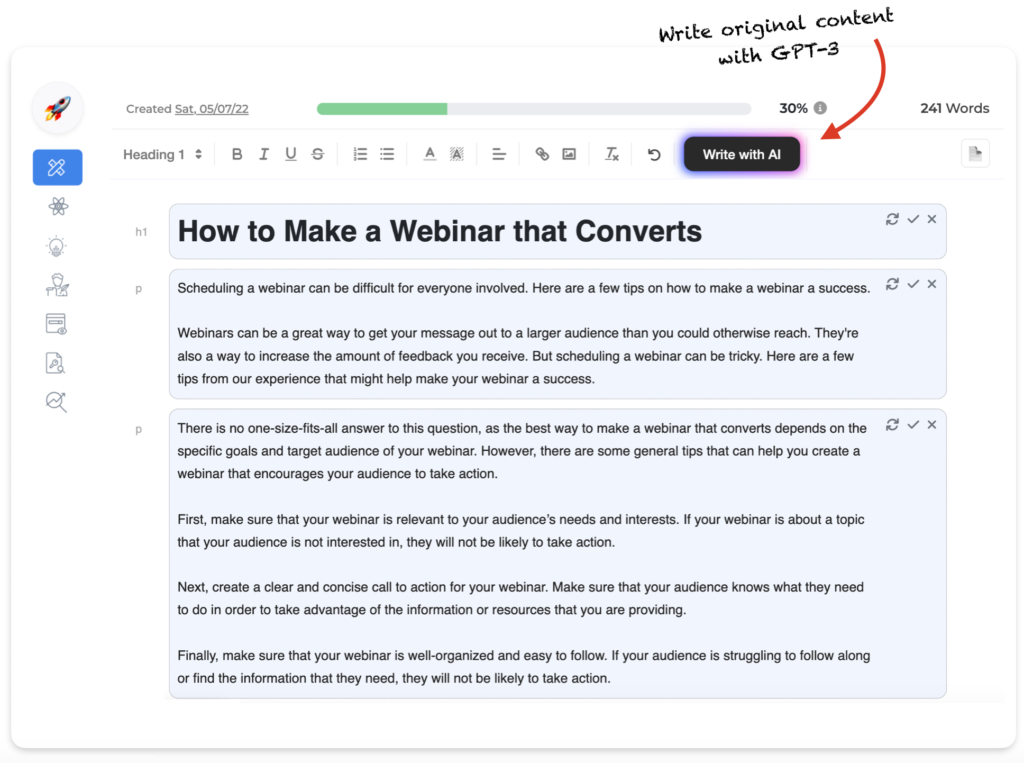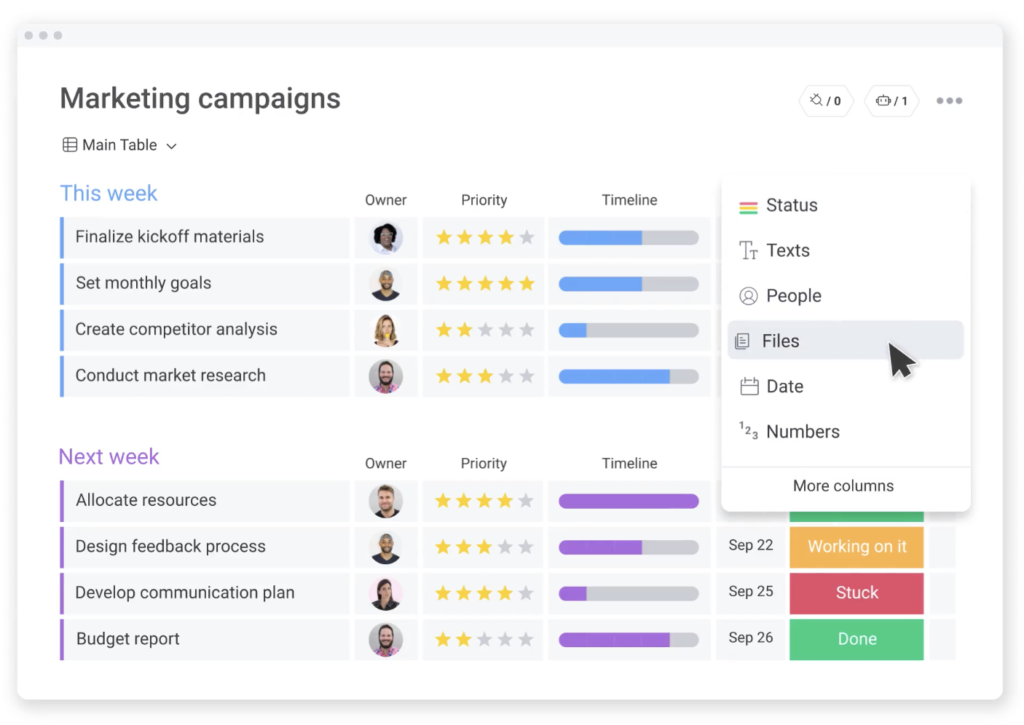- How to Get Internal Linking for SEO Right - November 16, 2022
- How to Scale Content Creation - May 30, 2022
Ended soon
Scaling your content creation efforts is a key way to increase brand awareness and drive customers to your acquisition funnel. Investing the right time and resources toward your content operation should result in high-quality, high-volume output that increases your website’s traffic and visibility in the search engines.
This can be challenging. In fact, the Content Marketing Institute reported that 64% of content marketers say that one of the biggest knowledge gaps for them is understanding how to build a scalable content strategy.
This post will explain what content creation is, why scaling it is important, and how you can scale to a high quantity of content while maintaining top-notch quality.

Table of Contents
What is Scalable Content Production and Why Is it Important?
Scalable content production is about more than just increasing the number of posts to your blog. If you were focused on just that, you’d wind up with a bunch of jumbled posts that don’t necessarily align with your customer’s needs.
Content production is typically focused on one of two key goals:
- Providing the user (or customer) of your product with as much information as possible to guide them through their buying journey.
- Driving organic traffic to your website.
Both of these require quite a bit of lift. Providing the user with necessary information means developing educational resources around every area of your product.
Driving organic traffic requires that you have an entire library of content devoted to the topic you are claiming expertise on. Without a library, Google will not reward your efforts. This is because they want to see that your site is a topical authority. This requires a library covering everything there is to know about a given topic. Without a built out library, it will be very difficult to drive traffic from a search engine.
For these reasons, it’s important that you invest in the scope and scale of your content. Without proper investment, you will certainly not see the results that you want.
Understand Each Step Required for Your Content Production Line
If you thought generating good content was as simple as having a writer execute, think again. There are several steps leading up to the writing process, and several more that follow once the content has been written.
Understanding the steps required for your specific business is key to scaling your content operation. Here are the steps I use to ensure quality content creation.
- Topic identification
Decide what key topic you are hoping to tackle in your content. This can be informed by a business need (i.e. an explanatory article that covers a question coming up for your customer) or an organic growth driver (i.e. answering a question people are asking on Google).
- Keyword research
Once you’ve decided on an article topic, you’ll need to understand ALL of the different terms people are looking up that relate to the topic you’re covering.
For example, if you are writing an article about How to Plant a Garden, you might find that there are keywords about vegetable gardens, flower gardens, etc.
Keyword research will help you gain an understanding of what topics your article will need to cover to be comprehensive.
- Outline
Outlining your content is key. This is how you ensure the writer hits on all the topics you’ve identified in your keyword research. The more detailed this piece is, the better your end result will be.
- Writing
Perhaps the most self-explanatory step in this guide, but do not discount how important this is. I recommend working with writers you can trust that have expertise on the subject matter. If, for example, you’re writing about health topics, you’ll want to hire experienced health journalists and content creators. It makes the whole process a whole lot easier.
- Editing
Behind every good writer is a great editor. It sounds obvious, but don’t make the mistake of putting up an article without having another human being read through it. Even the best writers don’t get everything right on the first try. Invest in editing wherever possible.
- Optimize for SEO
This step is most important if your content production is focused on driving organic traffic. If it is, you’ll want to make sure you optimize.
Optimization involves:
- Keyword allocation: Making sure all of the appropriate keywords have been included in your content will be key to whether Google can understand that your content is about the given subject.
- Meta title and description writing: This is important. These fields are what Google looks to to identify high-level what the content is about. Make sure you check the search engine results page to align your title and description with the ones that are successfully ranking.
- Interlinking: As we’ve discussed, good content is nothing if it exists alone on a website. A library content is key to your success. Optimization should include links to other pieces of content on the site so that Google sees how everything is related.
You can do optimization manually (i.e. have a person do it) or leverage an automated optimization tool like GrowthBar. In my career, I’ve found that automated tools make all the difference in creating and scaling an efficient process. I recommend using one if you have the budget to do so.
- Visuals
Web content containing visuals has been found to receive up to 94% more views than content without visuals. Make sure you are including relevant images, infographics and explanatory visuals wherever possible in your content.
Ideally, these visuals are created in-house by a design team. But that isn’t always possible. Another great way to leverage relevant images is using a tool that aggregates them. Growth Bar has an awesome feature that automates this piece of the process.
- Production
Production is when you build the beautiful content you’ve created in your content management system (CMS). It is key to the success of your content. Make sure you have a checklist for whoever is doing your production. This will ensure that they double check formatting, links, images, and other important features that will affect the quality of your content.
- Publish
Speaks for itself. This is when you finally get to put your content out into the world.
As you can see, a content operation is no small task. As you look to scale, you want to make sure that each of these steps maintains top-notch quality. Otherwise, your efforts will not reap the reward you are looking for.
Hire an All Star Team
As you can see, there are tons of steps to content production. The key to scaling successfully is to hire people for roles that you feel less confident or enthusiastic about. This way you can speed up the parts of the process that don’t suit you and continue doing the things you are good at.
For example, when I was scaling my content team at my last startup, I tried to play to my strengths and weaknesses.
I am a good technical resource, keyword researcher, strategic thinker, and writer. I’m less good at production, freelance management, and branded content. So as we scaled the team we hired for, we focused on hiring a content manager that could oversee production, a branded content / editorial thinker, and a freelance team to support those folks.
You’ll need to evaluate which steps of the process can be handled by whom. At the bare minimum, you’ll likely need to find people to fill the following roles:
- Writer
- Editor
- SEO Strategist
- SEO Content Specialist
- Content Producer
- or an SEO agency
Outsourcing vs. In-house
If you’ve worked anywhere trying to start something from scratch, you’ll be familiar with this age-old debate: do we hire in-house for our needs, or are contractors and outsourced employees enough to make the engine run?
Also read: The 7 Best Article Writing Services
In my experience, there are right and wrong answers to this question.
When you are trying to build for scale, certain parts of the team can (and should!) be outsourced. This is true for writers, editors, and producers. For these roles, outsourcing can often work best because you’re able to hire more people in a cost-efficient manner. The nature of these roles is executional, so you won’t be worrying about whether their work aligns with your strategy – you’ll have assigned it out so that it does!
In that same vein, there are certain parts of the team that absolutely should be in-house if possible. Your SEO strategists, content specialists, and technical SEO team should all be in house. That is because these folks are responsible for setting and executing a strategy. Having them all on the same team will help your strategic alignment and allow you to scale faster.
Automate Where Possible
As you can see by now, building and scaling an efficient content pipeline is a massive undertaking. In recent years, tons of tools have been created to help alleviate the manual burden of creating content.
One of the best things to come out of this wave of technology are SEO automation tools. My favorite tools to work with automate the content outline and optimization pieces of the puzzle.
GrowthBar has done an awesome job of this. All you need to jumpstart the outline process is your main targeted keyword.
With that, the tool will scan the internet and design a custom content outline that is optimized to rank. They provide all of the necessary keywords, images, and formatting that will best suit the audience. Plus, the AI content generation means you can create an entire article without writing a word yourself.

Then, when your content is written (by a human writer, ideally), you can paste it back in the tool and find out whether it has been properly optimized. If not, the tool will identify which keywords and topics are missing. If yes, you’ll know you are good to produce and publish the content.
Making a Great Content Calendar
A content calendar will be key to the success of your content. As you can see above, there are a lot of moving parts to creating successful content.

When you’re a one-person machine doing every step yourself, you can keep track of lots of that in your head.
But when you’re looking to scale, you’ll likely need to bring other people in to help. This is where the calendar becomes key.
Having all of your content outlined ahead of time will help every player in your content production machine stay aligned and on track. Without it, you’ll slow yourself and your teammates down.
Leverage Your Content Across Platforms
It sounds obvious, but scaling a successful content program means making sure that your content can serve multiple purposes. For example, an SEO article should have an image that can also be leveraged for social media. It should also be placed in the newsletter, and in any other content distribution your team is doing. Cross-pollinating your content ensures that you are getting the absolute maximum bang for your buck across each step of the production process. It also ensures people read your content, which is, of course, the goal.

Conclusion
As you’ve by now seen, a successfully scalable content creation operation requires a ton of work.
There are tons of steps involved in creating a single piece of content, and scaling requires figuring out which of those steps can be outsourced or automated for efficiency. Automation is always the preferred route because it will shave hours and hours off of your production process. Outsourcing is better for things that can’t be automated and are not strategic.
Ultimately, figuring out which pieces of this puzzle work will be specific to your content team. I recommend mapping it all out as I have done above and assigning roles accordingly.
Then, if you find things aren’t working or moving slower then you’d like, you can revisit the map and move things around.
Scaling a content creation team can take a lot of trial and error, but it is worth the extra work. Content can make all the difference in the success of your business.
It is definitely a worthwhile endeavor if you can figure out how all of the pieces fit together. Hopefully this article provided some clarity into that process.




